
Cast * Story * Interesting Facts * Disney Rivalry * Production Details * Behind the Scenes * Interviews * Deleted Scenes * PDI

Cast * Story * Interesting Facts * Disney Rivalry * Production Details * Behind the Scenes * Interviews * Deleted Scenes * PDI
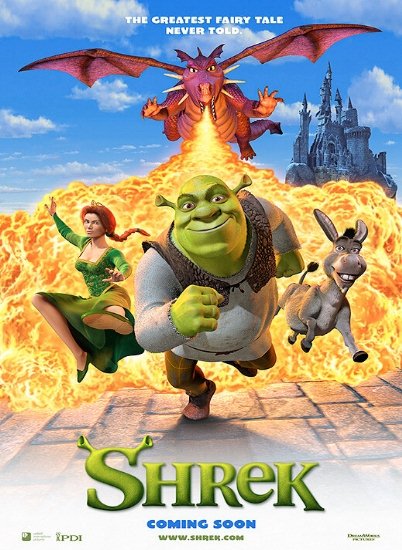 Directed
by: Andrew Adamson & Victoria Jenson
Directed
by: Andrew Adamson & Victoria Jenson
Written by: Ted Elliot & Terry
Rossio (based on the picture book by William Steig)
Music by: John Powell
Production Started On: October 15, 1996
Released on: The film will be released
on May 18, 2001; the $10 million plan to release an enhanced ending filled
with 3D effects and created just for the 3-D IMAX, in December 2001 to
coincide with the home video release of Shrek, has been cancelled.
Running Time: 89 minutes
Budget: $60 million
plus $45 million in marketing costs
U.S. Opening Weekend: $42.347 million
over 3,587 screens
Box-Office: $267.65 million in the U.S.
(plus 24 million units sold on DVD and VHS), $482.2 million worldwide
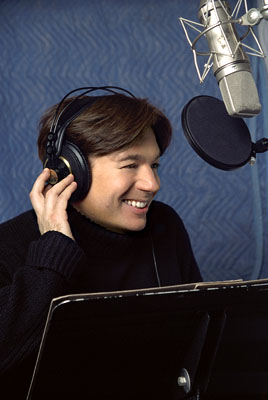 |
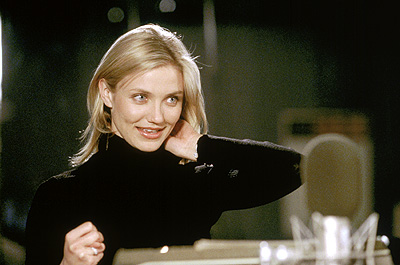 |
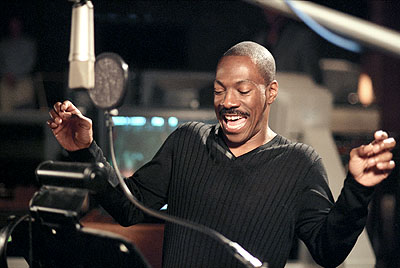 |
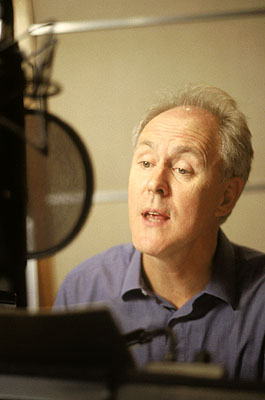 |
 |
Shrek...
Mike Myers
Princess Fiona... Cameron Diaz (this character was originally
casted as Janeane Garofalo)
Donkey... Eddie Murphy
Lord Farquaad... John Lithgow
The Witch... Linda Hunt
The evil Lord Farquaad, a 4-foot tall anal-retentive tyrant, wants his kingdom of Dulok to include no fairy tale creatures. The trouble is, he isn't a king! Therefore, he must marry the Princess -but she has a dark secret of her own.
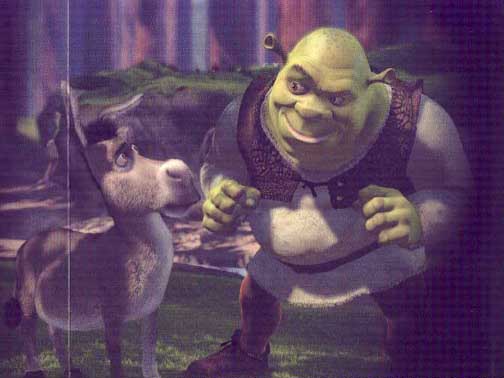 The
opening scene shows Shrek, a feisty, hideous ogre, walking out of his hut,
doing his morning ritual of breakfast, brushing his teeth with squished
bugs, farting and belching. To Shrek's surprise and displeasure,
he finds his swamp over-run by various fairytale creatures who've been
kicked out of Dulok by Lord Farquaad because they do not fit into his vision
of the perfect kingdom. Shrek sets off to confront Farquaad about
getting the creatures out of his swamp. On the way, he saves Donkey's life,
and finds he now has a new best friend -and unwanted sidekick.
The
opening scene shows Shrek, a feisty, hideous ogre, walking out of his hut,
doing his morning ritual of breakfast, brushing his teeth with squished
bugs, farting and belching. To Shrek's surprise and displeasure,
he finds his swamp over-run by various fairytale creatures who've been
kicked out of Dulok by Lord Farquaad because they do not fit into his vision
of the perfect kingdom. Shrek sets off to confront Farquaad about
getting the creatures out of his swamp. On the way, he saves Donkey's life,
and finds he now has a new best friend -and unwanted sidekick.
 Meanwhile,
Farquaad tortures the Gingerbread Man for information on where the fairy
creatures are hiding, by ripping off his legs and dipping him in milk.
As the Gingerbread Man confesses, Farquaad's guards interrupt, bringing
in the Magic Mirror. He asks the mirror if he has the most perfect kingdom,
to which the mirror informs him that this technically isn't a kingdom because
he isn't a king, and that he must marry a princess to become a king. The
mirror then shows him in dating game style the top three eligible princesses
including Sleeping Beauty, and Cinderella, who he rejects in favor of Fiona,
who's being held in a tower against her will by a ferocious dragon. The
mirror tries to tell him something more about her, but he's no longer listening,
having decided to hold a tournament to find the best warrior to rescue
her.
Meanwhile,
Farquaad tortures the Gingerbread Man for information on where the fairy
creatures are hiding, by ripping off his legs and dipping him in milk.
As the Gingerbread Man confesses, Farquaad's guards interrupt, bringing
in the Magic Mirror. He asks the mirror if he has the most perfect kingdom,
to which the mirror informs him that this technically isn't a kingdom because
he isn't a king, and that he must marry a princess to become a king. The
mirror then shows him in dating game style the top three eligible princesses
including Sleeping Beauty, and Cinderella, who he rejects in favor of Fiona,
who's being held in a tower against her will by a ferocious dragon. The
mirror tries to tell him something more about her, but he's no longer listening,
having decided to hold a tournament to find the best warrior to rescue
her.
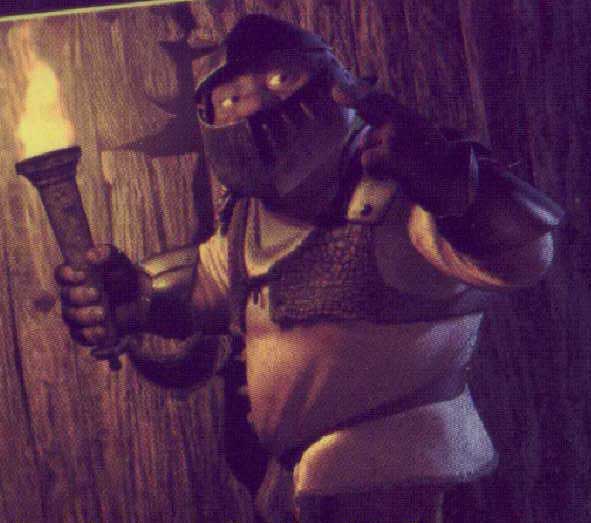 The
knights assemble just as Shrek and Donkey come walking up. Farquaad tells
the warriors that the one to slay the ogre will be named the winner. What
ensues is a W.W.F style fight in which Shrek defeats all the knights.
Shrek is named the winner and strikes a bargain that if he rescues Fiona,
Farquaad will have to get rid of the fairy creatures in his swamp.
The
knights assemble just as Shrek and Donkey come walking up. Farquaad tells
the warriors that the one to slay the ogre will be named the winner. What
ensues is a W.W.F style fight in which Shrek defeats all the knights.
Shrek is named the winner and strikes a bargain that if he rescues Fiona,
Farquaad will have to get rid of the fairy creatures in his swamp.
Shrek and Donkey set off to rescue the princess, and get to the castle where Fiona is being held -Donkey goes looking for the stairs while Shrek looks for the dragon. Unfortunately, Donkey finds the dragon, who is apparently female, and she falls in love with him as he flatters her to save his life. Shrek finds Fiona, who's expecting to be awakened with a kiss and swept off her feet, but Shrek rudely shakes her awake and tells her to follow him. He starts to fight the dragon, but Donkey says they're friends, and they leave to make their way back to Dulok.
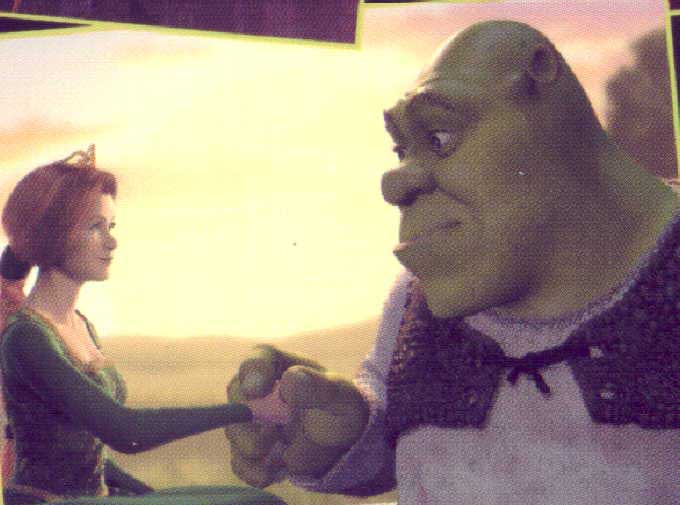 On
the way back, Shrek and Fiona start to like each other. They have
a great day by a windmill where they're spending the night, but just as
the sun starts to set, she runs inside the windmill and shuts the door.
Shrek can't figure out what happened, so he goes off to get her flowers.
As they're talking, Shrek walks up and overhears Fiona asking herself how
anyone could love something so hideous -he misinterpret it, assuming she's
talking about him, and decides to bring Farquaad to her and get back to
his swamp where he belongs.
On
the way back, Shrek and Fiona start to like each other. They have
a great day by a windmill where they're spending the night, but just as
the sun starts to set, she runs inside the windmill and shuts the door.
Shrek can't figure out what happened, so he goes off to get her flowers.
As they're talking, Shrek walks up and overhears Fiona asking herself how
anyone could love something so hideous -he misinterpret it, assuming she's
talking about him, and decides to bring Farquaad to her and get back to
his swamp where he belongs.
As Farquaad and Fiona begin the wedding ceremony, Shrek finds out the
truth...
INTERESTING
FACTS
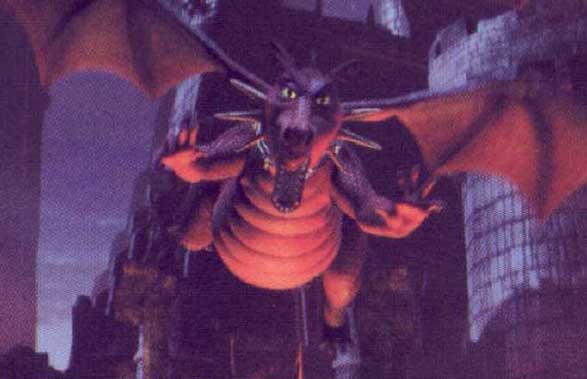
![]() Shrek
is DreamWorks' second big 3D release from PDI, the first being
Antz.
It is written by Ted Elliot and Terry Rossio, both who wrote Disney's Aladdin
and DreamWorks upcoming The Road to
El Dorado. You can check out a behind-the-scenes
featurette now!
Shrek
is DreamWorks' second big 3D release from PDI, the first being
Antz.
It is written by Ted Elliot and Terry Rossio, both who wrote Disney's Aladdin
and DreamWorks upcoming The Road to
El Dorado. You can check out a behind-the-scenes
featurette now!
![]() Producer John
H. Williams got the idea to adapt Shrek from his then pre-school
aged sons. "To me it smacked of being a Nickelodeon type project. At the
time they were very successful because kids want stuff that is iconoclastic.
I've never had it before or since, but Shrek was effectively given a greenlight
on the spot by Jeffrey Katzenberg who said that he was going to make it.
I had other options, Miramax had been interested in it also and had wanted
to use Henry Selick who [directed] Nightmare
Before Christmas and James
and the Giant Peach. Henry entered an exclusive deal with Miramax
and I knew that he was an impressive, talented guy, but DreamWorks on the
spot said, 'We will make this movie.' You know what? The process began
immediately. We started doing character creation simultaneously with the
earliest work on the outline with the writers. To me, it was the coolest
process too, because there were so many voices that weighed in and made
a huge impact in the evolution of it, which included storyboard artists
and animators. It was much more of a collaborative enterprise than a live
action film in a way. The credited writers all made an important, significant
contribution, but the storyboard artists also made a huge and unrecognized
story contribution..."
Producer John
H. Williams got the idea to adapt Shrek from his then pre-school
aged sons. "To me it smacked of being a Nickelodeon type project. At the
time they were very successful because kids want stuff that is iconoclastic.
I've never had it before or since, but Shrek was effectively given a greenlight
on the spot by Jeffrey Katzenberg who said that he was going to make it.
I had other options, Miramax had been interested in it also and had wanted
to use Henry Selick who [directed] Nightmare
Before Christmas and James
and the Giant Peach. Henry entered an exclusive deal with Miramax
and I knew that he was an impressive, talented guy, but DreamWorks on the
spot said, 'We will make this movie.' You know what? The process began
immediately. We started doing character creation simultaneously with the
earliest work on the outline with the writers. To me, it was the coolest
process too, because there were so many voices that weighed in and made
a huge impact in the evolution of it, which included storyboard artists
and animators. It was much more of a collaborative enterprise than a live
action film in a way. The credited writers all made an important, significant
contribution, but the storyboard artists also made a huge and unrecognized
story contribution..."
![]() Eddy Murphy's
character Donkey was originally named "Little Ass"!
Eddy Murphy's
character Donkey was originally named "Little Ass"!
![]() The film's story
originally followed the adventures of a teenage ogre who just didn't want
to lurk around the swamp and frighten people. Shrek (who was basically
a sweet, well intentioned soul) wanted to do good. His ultimate dream was
to become a knight and rescue fair damsels in distress. In this version
of the film, Princess Fiona was voiced by rather gruff, sarcastic female
comic Janeane Garofalo. The princess was the one who didn't trust people,
and it was Shrek's sweetness, kind heart and good nature that eventually
caused Fiona to open her eyes and learn that it was wrong to judge a person
just based on how they looked. "Were you to ask the folks at Dreamworks,
they'd probably still tell you that the Chris Farley version of Shrek
would have been infinitely better than the Michael Myers / Cameron Diaz
version that the studio eventually released in May of 2001," according
to Jim Hill Media. But Chris
Farley's tragic death in December 1997 caused a ripple effect. Since Chris
was no longer available to record the rest of his dialogue for Shrek's
title character, Dreamworks had no choice but to chuck everything that
they'd done up until that point and start the movie from scratch. This
mean recasting the role. But Chris's fellow SNL-er Mike Myers seemed incapable
of playing a sweet, sincere character, which meant that the ogre's part
in the picture was going to have to be radically rewritten to play to Myer's
strengths. Which is how the gruff, emotionally remote version of the film's
title character came in being. Of course, given that the title character
of Shrek was now going to be sarcastic and nasty, that meant that the role
of Princess Fiona would have to be rewritten as well. Which is why Janeane
Garfofalo suddenly found herself out on the street while Cameron Diaz was
brought in to play the kinder, gentler version of Fiona.
The film's story
originally followed the adventures of a teenage ogre who just didn't want
to lurk around the swamp and frighten people. Shrek (who was basically
a sweet, well intentioned soul) wanted to do good. His ultimate dream was
to become a knight and rescue fair damsels in distress. In this version
of the film, Princess Fiona was voiced by rather gruff, sarcastic female
comic Janeane Garofalo. The princess was the one who didn't trust people,
and it was Shrek's sweetness, kind heart and good nature that eventually
caused Fiona to open her eyes and learn that it was wrong to judge a person
just based on how they looked. "Were you to ask the folks at Dreamworks,
they'd probably still tell you that the Chris Farley version of Shrek
would have been infinitely better than the Michael Myers / Cameron Diaz
version that the studio eventually released in May of 2001," according
to Jim Hill Media. But Chris
Farley's tragic death in December 1997 caused a ripple effect. Since Chris
was no longer available to record the rest of his dialogue for Shrek's
title character, Dreamworks had no choice but to chuck everything that
they'd done up until that point and start the movie from scratch. This
mean recasting the role. But Chris's fellow SNL-er Mike Myers seemed incapable
of playing a sweet, sincere character, which meant that the ogre's part
in the picture was going to have to be radically rewritten to play to Myer's
strengths. Which is how the gruff, emotionally remote version of the film's
title character came in being. Of course, given that the title character
of Shrek was now going to be sarcastic and nasty, that meant that the role
of Princess Fiona would have to be rewritten as well. Which is why Janeane
Garfofalo suddenly found herself out on the street while Cameron Diaz was
brought in to play the kinder, gentler version of Fiona.
![]() After Mike Myers
completed his dialogue in his own voice and Shrek's animation was being
completed, Myers decided he wanted to give Shrek a Scottish accent. "Once
I saw the whole picture, I saw I needed to dig even deeper. And in having
Shrek be Scottish, I was able to tap into a certain energy." When his mother,
who is from Liverpool, read him books like Babar or Curious
George she often gave British dialects to the characters. "It was
a happy memory of my childhood, and in Scottish I was able to connect to
that." When Mike Myers begged to be allowed to redo Shrek's voice, Jeffrey
Katzenberg and his partner Steven Spielberg agreed after hearing a demo,
although the decision required the ogre to be reanimated from scratch.
"That incident cost us about $5 million," said Jeffrey Katzenberg. "But
it's Mike's total creation, and honestly, it made the movie so much better."
After Mike Myers
completed his dialogue in his own voice and Shrek's animation was being
completed, Myers decided he wanted to give Shrek a Scottish accent. "Once
I saw the whole picture, I saw I needed to dig even deeper. And in having
Shrek be Scottish, I was able to tap into a certain energy." When his mother,
who is from Liverpool, read him books like Babar or Curious
George she often gave British dialects to the characters. "It was
a happy memory of my childhood, and in Scottish I was able to connect to
that." When Mike Myers begged to be allowed to redo Shrek's voice, Jeffrey
Katzenberg and his partner Steven Spielberg agreed after hearing a demo,
although the decision required the ogre to be reanimated from scratch.
"That incident cost us about $5 million," said Jeffrey Katzenberg. "But
it's Mike's total creation, and honestly, it made the movie so much better."
![]() Co-director Andrew
Adamson is the screaming voice of the big head fellow who was greeting
people in front of Duloc, while the Head of PDI, Aron Warner, voiced the
wolf.
Co-director Andrew
Adamson is the screaming voice of the big head fellow who was greeting
people in front of Duloc, while the Head of PDI, Aron Warner, voiced the
wolf.

![]() A nearly finished version of Shrek was shown on March 6, 2001 ShoWest
exhibitors convention. "There's still some hand-drawn animation, and all
the coloring's not there. But a big percentage is complete, and the story
and the words are all there," said DreamWorks distribution head Jim Tharpe.
Tharpe said the film would be fully completed on-schedule in April 2001,
when the studio would show the completed version to promotional partners
and critics' junkets. "But we wanted to be able to show it now to our exhibitor
partners," he said. "It's a movie that we're proud of." After Andrew
finished his spiel, co-director Vicky Jenson jumped in with her analysis
of the story. "The whole tone of our film is just a little bit unexpected.
This is a fairy tale that doesn't go where you expect it to go. We have
a hero who is supposed to be the villain of every other fairy tale. We
have this monster, an ogre who finds himself a hero rescuing this princess.
We wanted to play with fairy tales and get the social expectations that
they have kind of led us all to grow up with, one of them
A nearly finished version of Shrek was shown on March 6, 2001 ShoWest
exhibitors convention. "There's still some hand-drawn animation, and all
the coloring's not there. But a big percentage is complete, and the story
and the words are all there," said DreamWorks distribution head Jim Tharpe.
Tharpe said the film would be fully completed on-schedule in April 2001,
when the studio would show the completed version to promotional partners
and critics' junkets. "But we wanted to be able to show it now to our exhibitor
partners," he said. "It's a movie that we're proud of." After Andrew
finished his spiel, co-director Vicky Jenson jumped in with her analysis
of the story. "The whole tone of our film is just a little bit unexpected.
This is a fairy tale that doesn't go where you expect it to go. We have
a hero who is supposed to be the villain of every other fairy tale. We
have this monster, an ogre who finds himself a hero rescuing this princess.
We wanted to play with fairy tales and get the social expectations that
they have kind of led us all to grow up with, one of them 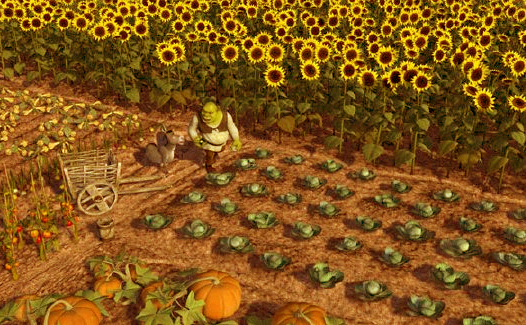 being
the fashion doll image that our Princess Fiona is dealing with. She believes
that this is how a princess is meant to look, the beautiful shape that
she's in. And she believes that she's supposed to have her ‘Prince Charming.’
And the bad guy of our story is actually the guy who's trying to be king.
So we just wanted to mess with some of those social norms and some of those
expectations of fairy tales that we've all grown up with. And we tried
to do it with a unique sense of humor that hopefully you will all pick
up." Adds Andrew: "It's very anachronistic."
being
the fashion doll image that our Princess Fiona is dealing with. She believes
that this is how a princess is meant to look, the beautiful shape that
she's in. And she believes that she's supposed to have her ‘Prince Charming.’
And the bad guy of our story is actually the guy who's trying to be king.
So we just wanted to mess with some of those social norms and some of those
expectations of fairy tales that we've all grown up with. And we tried
to do it with a unique sense of humor that hopefully you will all pick
up." Adds Andrew: "It's very anachronistic."
![]() Following an early
screening in New York, DreamWorks' co-honcho Jeffrey Katzenberg commented
that "technology is empowering us at a genuinely breathtaking rate — the
things we can do today we literally couldn't do a year or 18 months ago."
Following an early
screening in New York, DreamWorks' co-honcho Jeffrey Katzenberg commented
that "technology is empowering us at a genuinely breathtaking rate — the
things we can do today we literally couldn't do a year or 18 months ago."
![]() Fiona, the princess
heroine, originally was planned to be so real, she looked human. But next
to an ogre and a chatty donkey, a too-human-looking princess in peril seemed
out of place. "When we had placed Fiona in the movie, which is a
fairy-tale world, it looked completely wrong," says DreamWorks studio chief
Jeffrey Katzenberg. "It stood out. It didn't fit. It looked bad."
He pauses. "It looked like we made a mistake." Adds Shrek's co-director
Andrew Adamson: "With a talking donkey, you've got leeway because no one's
ever seen one. Fiona had to be a little bit stylized so she fit into this
somewhat surreal, illustrative world."
Fiona, the princess
heroine, originally was planned to be so real, she looked human. But next
to an ogre and a chatty donkey, a too-human-looking princess in peril seemed
out of place. "When we had placed Fiona in the movie, which is a
fairy-tale world, it looked completely wrong," says DreamWorks studio chief
Jeffrey Katzenberg. "It stood out. It didn't fit. It looked bad."
He pauses. "It looked like we made a mistake." Adds Shrek's co-director
Andrew Adamson: "With a talking donkey, you've got leeway because no one's
ever seen one. Fiona had to be a little bit stylized so she fit into this
somewhat surreal, illustrative world."
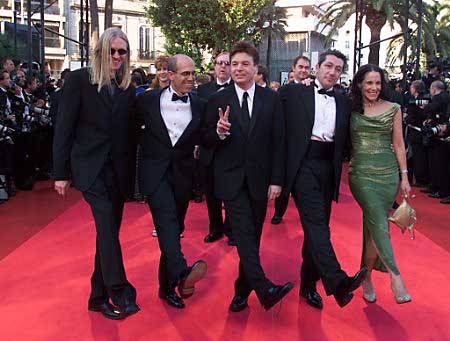
![]() Shrekis
the first cartoon feature to compete for the Cannes Film Festival's Palme
d'Or award in nearly a half century. The last animated film to be
selected for the competition was Disney's Peter
Pan in 1953. The photo on the right shows actor Mike Myers
(center) giving the 'V' for victory sign as he arrives between directors
Andrew Adamson (elft) and Vicky Jenson (right) as they raise their feet
in unison with DreamWorks producer Jeffrey Katzenberg (2nd left) and French
voice actor Alain Chabat (2nd right) during red carpet arrivals for Shrek's
official screening at the 54th International Cannes Film Festival, May
12, 2001.
Shrekis
the first cartoon feature to compete for the Cannes Film Festival's Palme
d'Or award in nearly a half century. The last animated film to be
selected for the competition was Disney's Peter
Pan in 1953. The photo on the right shows actor Mike Myers
(center) giving the 'V' for victory sign as he arrives between directors
Andrew Adamson (elft) and Vicky Jenson (right) as they raise their feet
in unison with DreamWorks producer Jeffrey Katzenberg (2nd left) and French
voice actor Alain Chabat (2nd right) during red carpet arrivals for Shrek's
official screening at the 54th International Cannes Film Festival, May
12, 2001.
![]() The animation
of Shrek takes some cues from lessons PDI learned on Antz.
Lead character animator Raman Hui, a 12 year veteran of PDI, explained
how his team added touches of realism to the storybook characters.
"One thing we felt was the characters we had done on Antz
were lacking a little bit of breathing," Hui said. "When they talk or when
they act, sometimes you don't feel that they are breathing. That's one
thing that we applied to Shrek. Whenever we hear a little bit of
sound in the audio, like if Fiona is talking and she inhales a little bit,
we want to make sure that that shows in her body. Another thing we did
was put more emphasis on weight. Whenever they walk or they shift their
body, we want to make sure that weight is showing according to the characters.
When Shrek walks, we want to make sure that you can feel that he's
heavy, so the body might bend a little bit more and the hip would turn
to make sure that his left leg has all the weight on the foot and those
kind of details."
The animation
of Shrek takes some cues from lessons PDI learned on Antz.
Lead character animator Raman Hui, a 12 year veteran of PDI, explained
how his team added touches of realism to the storybook characters.
"One thing we felt was the characters we had done on Antz
were lacking a little bit of breathing," Hui said. "When they talk or when
they act, sometimes you don't feel that they are breathing. That's one
thing that we applied to Shrek. Whenever we hear a little bit of
sound in the audio, like if Fiona is talking and she inhales a little bit,
we want to make sure that that shows in her body. Another thing we did
was put more emphasis on weight. Whenever they walk or they shift their
body, we want to make sure that weight is showing according to the characters.
When Shrek walks, we want to make sure that you can feel that he's
heavy, so the body might bend a little bit more and the hip would turn
to make sure that his left leg has all the weight on the foot and those
kind of details."
![]() Shrek bowed
in the second most number of theaters ever playing, right behind The
Lost World with 3,587 houses. Its $42.1 million weekend opening
was the second biggest ever for an animated film with Toy
Story 2 holding the top spot with its $57.3 million from November
of 1999. Shrek became also DreamWorks' biggest opening ever as Gladiator
previously held the record with its $34.8 million.
Shrek bowed
in the second most number of theaters ever playing, right behind The
Lost World with 3,587 houses. Its $42.1 million weekend opening
was the second biggest ever for an animated film with Toy
Story 2 holding the top spot with its $57.3 million from November
of 1999. Shrek became also DreamWorks' biggest opening ever as Gladiator
previously held the record with its $34.8 million.
![]() The film reached
the $100 million mark after 11 days equaling the time it took Toy
Story 2 and The Lion King
to tie for the fastest animated film to reach the $100 million mark.
But it passed the $150 million mark on its 18th day of release, making
it the fastest animated film ever to reach that mark! It became the
second-biggest animated hit of all time, behind Disney's The
Lion King.
The film reached
the $100 million mark after 11 days equaling the time it took Toy
Story 2 and The Lion King
to tie for the fastest animated film to reach the $100 million mark.
But it passed the $150 million mark on its 18th day of release, making
it the fastest animated film ever to reach that mark! It became the
second-biggest animated hit of all time, behind Disney's The
Lion King.
![]() Like most animated films, the exact cost of DreamWorks' Shrek is
difficult to calculate. That's true even for the studio producing it because
animation studios often work on more than one project at a time.
DreamWorks officially acknowledges Shrek's cost to be $48 million
to $50 million. That doesn't include the cost of a couple of false starts
on the film with other computer animation techniques, as well as carrying
costs for a years-long gestation period. The $60-million cost estimate
in The Times' chart, therefore, is just that. The total expenditures charged
against the movie actually may be higher. But with no profit participants
and a bonanza awaiting the film in the home video, DVD and foreign markets,
"Shrek" looks to be the most profitable movie in the fledgling studio's
history.
Like most animated films, the exact cost of DreamWorks' Shrek is
difficult to calculate. That's true even for the studio producing it because
animation studios often work on more than one project at a time.
DreamWorks officially acknowledges Shrek's cost to be $48 million
to $50 million. That doesn't include the cost of a couple of false starts
on the film with other computer animation techniques, as well as carrying
costs for a years-long gestation period. The $60-million cost estimate
in The Times' chart, therefore, is just that. The total expenditures charged
against the movie actually may be higher. But with no profit participants
and a bonanza awaiting the film in the home video, DVD and foreign markets,
"Shrek" looks to be the most profitable movie in the fledgling studio's
history.
![]() The marketing
industry trade magazine Brandweek put
the figure at more than $100 million between DreamWorks and its tie-in
partners. The promotional campaign includes everything from dolls
and plush figures that speak, to green Heinz EZ Squirt ketchup bottles,
green and purple Baskin-Robbins ice-cream and a "Shrek Swamp Fizz'' drink
that bubbles, fizzes and pops like a magic potion. The battle for
merchandising between Disney and DreamWorks is shaping up as a proxy war
between fast-food giants. Burger King does not have an exclusive deal with
DreamWorks, as McDonald's Corp. does with Disney, but the burger restaurant
chain is estimated to have put $20 million into its "Shrek" campaign.
The marketing
industry trade magazine Brandweek put
the figure at more than $100 million between DreamWorks and its tie-in
partners. The promotional campaign includes everything from dolls
and plush figures that speak, to green Heinz EZ Squirt ketchup bottles,
green and purple Baskin-Robbins ice-cream and a "Shrek Swamp Fizz'' drink
that bubbles, fizzes and pops like a magic potion. The battle for
merchandising between Disney and DreamWorks is shaping up as a proxy war
between fast-food giants. Burger King does not have an exclusive deal with
DreamWorks, as McDonald's Corp. does with Disney, but the burger restaurant
chain is estimated to have put $20 million into its "Shrek" campaign.
![]() After Neil Diamond
went to see the DreamWorks animated hit, he heard a group of giggling youngsters
singing "I'm a Believer" in the lobby of the theater. "I couldn't resist.
I went over and joined in, and we just sang the song together," the 61-year
old singer-songwriter revealed in Decembre 2002. "They had no idea that
I had written it, or who I was. I was just some weird guy who wanted to
join in on the singing."
After Neil Diamond
went to see the DreamWorks animated hit, he heard a group of giggling youngsters
singing "I'm a Believer" in the lobby of the theater. "I couldn't resist.
I went over and joined in, and we just sang the song together," the 61-year
old singer-songwriter revealed in Decembre 2002. "They had no idea that
I had written it, or who I was. I was just some weird guy who wanted to
join in on the singing."
![]() It was announced
the week of Shrek's release that a sequel, Shrek
2, was already under way. It is currently scheduled for a December
19, 2003 release.
It was announced
the week of Shrek's release that a sequel, Shrek
2, was already under way. It is currently scheduled for a December
19, 2003 release.
![]() DreamWorks said
to still be toying with additional footage on coming DVD. Word has
it that the coming SHREK DVD may have some additional original animated
content created just for the format. According to Video Premiere News,
SHREK directors Vicky Jenson and Andrew Adamson are currently at work on
additional animation for the film's upcoming special addition DVD. This
footage will be used for the disc's menus. In addition, though D'Works
isn't talking, word has it that the disc's extra content may also include
animated material that was created to be shown at press functions but never
used in the film.
DreamWorks said
to still be toying with additional footage on coming DVD. Word has
it that the coming SHREK DVD may have some additional original animated
content created just for the format. According to Video Premiere News,
SHREK directors Vicky Jenson and Andrew Adamson are currently at work on
additional animation for the film's upcoming special addition DVD. This
footage will be used for the disc's menus. In addition, though D'Works
isn't talking, word has it that the disc's extra content may also include
animated material that was created to be shown at press functions but never
used in the film.
![]() Dreamworks considered
re-releasing the film to a limited number of theaters on November 2nd,
2001, against Pixar’s Monsters, Inc.,
but eventually decided against it.
Dreamworks considered
re-releasing the film to a limited number of theaters on November 2nd,
2001, against Pixar’s Monsters, Inc.,
but eventually decided against it.
![]() In just over four weeks,
Shrek
became the best-selling DVD of all-time. With more than 5.5 million DVDs
sold to consumers in North America, the big green Ogre surpassed the previous
record-holder Gladiator (which has sold over 5 million units in
one year). Retail has purchased a total of 7.3 million Shrek DVDs
and
In just over four weeks,
Shrek
became the best-selling DVD of all-time. With more than 5.5 million DVDs
sold to consumers in North America, the big green Ogre surpassed the previous
record-holder Gladiator (which has sold over 5 million units in
one year). Retail has purchased a total of 7.3 million Shrek DVDs
and
DreamWorks had to continue manufacturing new copies in an effort to
avoid selling out of the product prior to the Holidays. "This unprecedented
rate of sale confirms that the Shrek DVD is sought after by not
only the DVD collector, but also by the wide range of Shrek movie
fans including families with kids, teenagers, adults and everyone in between,"
commented Kelley Avery, worldwide head of DreamWorks Home Entertainment.
![]() DreamWorks movie studio
announced in early January 2002 that the green ogre has sold over $420
million worth of home videos and DVDs in just over two months on retail
shelves, adding to its $472 million (and counting) at global box offices.
DreamWorks said it has sold over 21 million VHS videotapes of Shrek,
a record 7.9 million DVDs in the United States and another 2.1 million
DVDs in international markets, making it the most popular video since all-time
bestseller The Lion King. Consumers
have spent more than $51 million renting VHS and DVD copies of Shrek
so far, according to Video Software Dealers Assn.'s VidTrac, ranking the
picture 29th on the rental charts for the year.
DreamWorks movie studio
announced in early January 2002 that the green ogre has sold over $420
million worth of home videos and DVDs in just over two months on retail
shelves, adding to its $472 million (and counting) at global box offices.
DreamWorks said it has sold over 21 million VHS videotapes of Shrek,
a record 7.9 million DVDs in the United States and another 2.1 million
DVDs in international markets, making it the most popular video since all-time
bestseller The Lion King. Consumers
have spent more than $51 million renting VHS and DVD copies of Shrek
so far, according to Video Software Dealers Assn.'s VidTrac, ranking the
picture 29th on the rental charts for the year.
![]() Shrek won the
first ever Best Animated Feature Oscar, beating Pixar and Disney's Monsters,
Inc. Specially designed clips showed the main characters from the
three nominated movies among the audience, crossing fingers before the
award, then a happy Shrek and Donkey, and disappointed Sulley, Mike and
Jimmy politely clapping. Nathan Lane (The
Lion King) presented the Award wearing Mickey Mouse gloves;
producer Aron Warner accepted it, crediting "Jeffrey Katzenberg who has
a love for animation that borders on obsession and is the real reason that
we're here tonight" -- a slap in the face for Disney. Shrek was
also nominated, but lost, for Best Adapted Screenplay at the 2001 Academy
Awards. Aron Warner added backstage that the victory for DreamWorks PDI
"is recognition of an amazing collaborative art form that’s been around
for a long, long time, and it’s evolving and starting to entertain wider
audiences — and maybe that’s why we’re here." When asked whether there
was a turning point when Shrek came together as a story, Warner replied:
"All animated stories are difficult, and it just kind of happened that
we found ourselves on the right path and looked around and said, ‘Hey,
it feels right — that’s where we’re going.’ It’s a long, drawn out development
process."
Shrek won the
first ever Best Animated Feature Oscar, beating Pixar and Disney's Monsters,
Inc. Specially designed clips showed the main characters from the
three nominated movies among the audience, crossing fingers before the
award, then a happy Shrek and Donkey, and disappointed Sulley, Mike and
Jimmy politely clapping. Nathan Lane (The
Lion King) presented the Award wearing Mickey Mouse gloves;
producer Aron Warner accepted it, crediting "Jeffrey Katzenberg who has
a love for animation that borders on obsession and is the real reason that
we're here tonight" -- a slap in the face for Disney. Shrek was
also nominated, but lost, for Best Adapted Screenplay at the 2001 Academy
Awards. Aron Warner added backstage that the victory for DreamWorks PDI
"is recognition of an amazing collaborative art form that’s been around
for a long, long time, and it’s evolving and starting to entertain wider
audiences — and maybe that’s why we’re here." When asked whether there
was a turning point when Shrek came together as a story, Warner replied:
"All animated stories are difficult, and it just kind of happened that
we found ourselves on the right path and looked around and said, ‘Hey,
it feels right — that’s where we’re going.’ It’s a long, drawn out development
process."
![]() Universal revealed in
January 2003 that it planned to open a new Shrek attraction at its
three theme parks (California, Florida, Japan) that would incorporate "state-of-the-art
technology that has never been seen." The attraction, to be called Shrek
4-D, will use the voices of Mike Myers, Eddie Murphy and Cameron Diaz
and will feature 15 minutes of 3-D ("Ogrevision") animation, the studio
said. The attraction will take up where the popular 2001 feature film ended
and lead into the 2004 theatrical sequel. Audience
members will sit in seats "capable of both vertical and horizontal motion
equipped with tactile transducers, pneumatic air propulsion and water spray
nodules."
Universal revealed in
January 2003 that it planned to open a new Shrek attraction at its
three theme parks (California, Florida, Japan) that would incorporate "state-of-the-art
technology that has never been seen." The attraction, to be called Shrek
4-D, will use the voices of Mike Myers, Eddie Murphy and Cameron Diaz
and will feature 15 minutes of 3-D ("Ogrevision") animation, the studio
said. The attraction will take up where the popular 2001 feature film ended
and lead into the 2004 theatrical sequel. Audience
members will sit in seats "capable of both vertical and horizontal motion
equipped with tactile transducers, pneumatic air propulsion and water spray
nodules."
![]() Rumors that DreamWorks
was developing Shrek into a Broadway musical emerged in October
2002. DreamWorks announced that acclaimed director Sam Mendes would direct
Shrek,
the Musical and was casting about for a book writer and songwriting
team. DreamWorks would officially like to have Shrek, the Musical
on the boards within three years--though sources revealed that the studio
really wants to workshop its first foray into the theatrical arena in early
2005.
Rumors that DreamWorks
was developing Shrek into a Broadway musical emerged in October
2002. DreamWorks announced that acclaimed director Sam Mendes would direct
Shrek,
the Musical and was casting about for a book writer and songwriting
team. DreamWorks would officially like to have Shrek, the Musical
on the boards within three years--though sources revealed that the studio
really wants to workshop its first foray into the theatrical arena in early
2005.
![]() DreamWorks said in February
2003 that the Shrek franchise was expected to deliver $1 billion in profits,
eventually.
DreamWorks said in February
2003 that the Shrek franchise was expected to deliver $1 billion in profits,
eventually.
Over the past years, Dreamworks has been
criticized for using ideas from Disney movies in the works, building a
plot around the same theme, and putting similar projects on faster tracks
-cheaper, quicker, released earlier. Former Disney honcho Jeffrey Katzenberg's
animosity towards Michael Eisner, who refused to give him the #2 spot in
the company, is said to be the main motivation behind this policy. That
is all the saddest since Dreamworks' team has shown, even through these
me-too projects, that talent was far from lacking in their studio!
Fortunately, this trend now seems to be fading.
|
|
|
|
| A comet needs to be destroyed before colliding with Earth. | Deep Impact
(May 8, 1998) |
Armageddon
(July 1, 1998) |
| The CGI adventures of insects. | Antz
(October 2, 1998) |
A Bug's Life
(November 20, 1998) |
| Two male buddies in a journey in ancient Latin America. | The Road to El Dorado
(March 31, 2000) |
The Emperor's New Groove
(December 15, 2000) |
| The CGI adventures of friendly monsters. | Shrek
(Spring 2001) |
Monsters, Inc.
(Thanksgiving 2001) |
| An animated western from the perspective of an animal. | Spirit
(A horse, 2002) |
Home on the Range
(A cow or bull, 2004) |
This time, the Walt Disney Co. attempted to block affiliates of the Radio Disney kids radio network from accepting promotions and advertisements for Shrek. A notice that appeared in Radio Disney's May 2001 affiliate newsletter read in part: "Due to recent initiatives with the Walt Disney Company, we are being asked not to align ourselves promotionally with this new release. Stations may accept spot dollars only in individual markets." Promotions and screenings for Shrek that had already been arranged in San Francisco, Chicago, Cleveland Phoenix and Seattle were canceled.
Nevertheless, demonstrating that cooperation is possible even among the bitterest rivals if the motivation exists, DreamWorks executives submitted a few scenes to Disney attorneys in advance so as to avoid a potential lawsuit. "We showed each and every scene to lawyers as we went along. We certainly did not want to be sued by Disney." explains co-director Andrew Adamson. "We wanted [the film's villain, Farquaad] to create a make-believe fantasy. We toyed with poking fun at Universal City and Las Vegas, but we decided the most recognizable one to children was also the most fun to play with. It's pretty hard to have fun with fairy tales without touching the biggest purveyor of fairy tales in the world."
And while some writers have suggested that the film represents a kind of personal attack by DreamWorks founder and ex-Disney exec Jeffrey Katzenberg on his former studio and its boss, Michael Eisner, Adamson remarked, "[Katzenberg] certainly enjoyed the jokes... Even when we made fun of Beauty and the Beast, which is one of the Disney movies he was proudest of being involved with...But the movie's too good-hearted to be any revenge-based thing. If people think that, they're really missing the point of the thing, which is to turn fairy tales on their ears."
Adamson laughs off talk that the film's villain is patterned after Disney big shot Michael Eisner, saying, "Other people are saying that Shrek is based on Michael Eisner. People are so into this rivalry that next they'll be saying that Fiona is based on Eisner!"
Steig's illustrations were the real inspiration for Shrek's design, Adamson explains. "The protruding ears and basic shapes are really close to Steig's drawings. When Mike Myers became involved, we added the pointed eyebrows. I always thought of the character as being like an English bulldog, which are perfectly horrible-looking yet somehow cute. And when you approach them, you almost invariably find they're very friendly dogs."
Katzenberg told Newsweek, "There's nothing [in the movie] in our view that is mean-spirited or nasty to the Disney heritage. It's not a revenge plot on my part." He added that Disney executives had been "gracious and complimentary" when he screened "Shrek" for them. Disney spokesmen have refused to comment on the film.
However, legendary Disney story artist Joe Grant, whose career stretches from Snow White and the Seven Dwarfs to Tarzan, and who helped to create many of the classic fairy tales, spoke enthusiastically about "Shrek," which he saw on his 93rd birthday. "I thought the parodies were harmless and funny, and I certainly wasn't offended by any of them," he said. "They're cute and cleverly handled; having Princess Fiona pretend to be sleeping so she can be rescued according to the book is really clever. I don't think they're destroying any icons. The film has a great contemporary feel to it--it's the sort of cartoon I like to see now: It's 2001."
Grant sums up the feelings of many animation artists when he concludes, "I hope the people in charge at DreamWorks and Disney continue pioneering in this area. They've proved computer animation is a great medium for satire and a different kind of fun: Drawn animation has some catching up to do. If 'Shrek' does well--and I hope it does--it will be good for the whole animation industry. It doesn't matter who made the film."
And indeed, Shrek did very well! The second highest grossing animated movie of all time (not adjusting for inflation), DreamWorks originally considered a Fall 2001 rerelease of Shrek into theaters with new footage that likely would have catapulted the film past The Lion King. Instead, DreamWorks has decided to launch a blatant attack against Pixar by releasing a special Shrek 2-disc DVD, with new footage, on the exact same day that Pixar's Monsters, Inc. hits theaters - November 2, 2001. That's a Friday, a day that studios never release DVDs or videos (video and DVD releases are always launched on Tuesdays). The move creates a danger for DreamWorks as some people's perceptions of the studio could change to that of a "bully" as it applies strong-arm tactics that use to be a virtual "trademark" of Disney.
In June 2001, DreamWorks pitched THX the idea of using the Shrek characters
in a new trailer. "THX seemed extremely excited by the idea and continued
to be excited and enthusiastic until a week and a half ago," said DreamWorks
marketing chief Terry Press, a week before the release of Monsters,
Inc. According to DreamWorks, this is when Pixar and its corporate
partner, Disney, caught wind of the completed trailer, which would have
played before Monsters, Inc. and several holiday films. DreamWorks
says that Disney threatened to pull all its business from THX, which also
oversees audio and video for DVDs, unless the promotional item was canceled.
A Pixar spokesman said, "We don't know anything about this." A ranking
Disney executive was dismissive about DreamWorks' claims. "I know our friends
at DreamWorks would love to blame us for everything."
 |
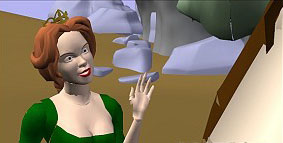 |
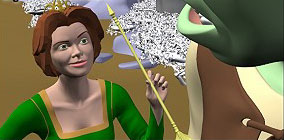 |
 |
The pre-production on Shrek started in 1995. Dreamworks first hired a motion capture company to develop it, wasting a year and a lot of money. Then, a small crack team took a couple of months to develop a 15-minute 3D demo, using the voices of actors Chris Farley and Janeane Garofalo: very disappointed by the results he saw in the summer of 1997, Jeffrey Katzeberg felt the project did not justify the very high CGI costs. He unsuccesfully shopped the project around to various studios, before hiring PDI (Antz) to do most of the character work as well as miniatures for backgrounds.
In December 1997, the future of Shrek seemed to grow even darker,
with the surprising death of its main voice character, 33-year-old Chris
Farley. "Chris Farley was our first choice to voice the ogre Shrek and
when he died, it was a huge personal loss and a setback for the film,"
recalls co-director Andrew Adamson. "Chris was such a sweet and vulnerable
person."
The project was then completely re-tooled: director Ron Tippe was replaced
by Kelly Asbury (who would soon move on to Spirit
of the West) and Andrew Adamson, John Garbett stepped down as producer
and writer Aron Warner (Antz) was hired.
The first act of the movie was re-written, and an all-star cast convinced
to join the project: Mike Myers, fresh from his Austin Powers fame,
replaced his late friend Chris Farley as the monster, while Something
about Mary star Cameron Diaz was substituted to Janeane Garofalo in
the role of the princess; Eddie Murphy (Mushu in Mulan)
accepted the role of the talking donkey, Linda Hunt that of the witch and
John Lithgow the villain's. The troubled movie then seemed to quickly
rise from its own ashes. Once Myers came on board, "we went back
to the drawing board to tailor it to Mike's talents. Suddenly, with
Mike in the lead, the ogre character came to have a Scottish accent. The
out-takes are hysterical. It's really too bad this could only be a 90-minute
movie", confessed Andrew Adamson.
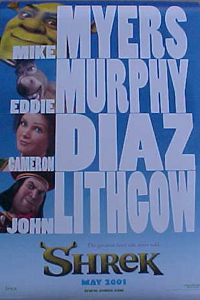 In
November 1998, it was announced that DreamWorks was seriously considering
releasing Shrek not only to Widescreen theaters, but also to IMAX
theaters in an IMAX format that would require rerendering (and assembling)
the entire animated film. It would give Shrek a true 3D look
and put DreamWorks in the record book with the first fully 3D animated
feature for IMAX. But in a surprising
move in February 1999, Disney invested in IMAX and scheduled Fantasia
2000 to be released on IMAX screens beginning January 1, 2000.
In
November 1998, it was announced that DreamWorks was seriously considering
releasing Shrek not only to Widescreen theaters, but also to IMAX
theaters in an IMAX format that would require rerendering (and assembling)
the entire animated film. It would give Shrek a true 3D look
and put DreamWorks in the record book with the first fully 3D animated
feature for IMAX. But in a surprising
move in February 1999, Disney invested in IMAX and scheduled Fantasia
2000 to be released on IMAX screens beginning January 1, 2000.
Nevertheless, on July 28, 2000 -the final day of the SIGGRAPH convention-,
a first-look session confirmed that Shrek would be hitting both
theatres and IMAX. Says a member of the audience: "The session that
I attended mainly dealt with the technical aspects of the movie (cloth,
fluids, environments), but there were a few finished shots that really
wowed the crowd. One shot consisted of Shrek, Donkey and the Princess walking
through a forest. The whole scene was really beautiful. Another scene was
with Shrek and Donkey walking through the mountains, with a grand sweeping
view of the valley. The coolest scene was in a small village. Shrek had
gotten into a fight with some locals. Near him were two extremely large
barrels of beer. Shrek smashed one open, and a torrent of beer flowed out,
causing the ground to become muddy, which was such a wonderful effect,
it still amazes me! I have really high expectations of this film after
attending this session. I'm guessing the trailer (or teaser) should be
out around Christmas".

"Animation is a constantly evolving artform,'' said DreamWorks SKG
principal Jeffrey Katzenberg, "and releasing Shrek in 3D form for
IMAX theatres will hopefully mark the next step in how audiences experience
these films. To tell a story in animation is always exciting ...
but to know that this fractured fairy tale will be shown eight stories
high and in IMAX 3D is thrilling for us at DreamWorks Animation.
Luckily in Mike Myers, Cameron Diaz, Eddie Murphy, John Lithgow and Linda
Hunt, we have a cast that is already big ... but it just got a whole lot
bigger.''
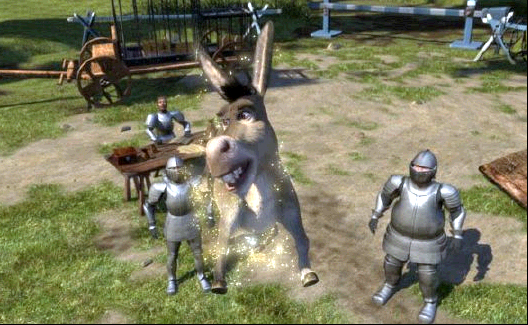 "We're
delighted that DreamWorks has decided to extend the Shrek franchise by
selecting IMAX 3D as a release window,'' said Imax co-CEOs Bradley J. Wechsler
and Richard L. Gelfond. "We believe that the combination of The IMAX 3D
Experience and the creative talents of DreamWorks SKG will revolutionize
the way people experience animation. This film will continue our
evolution as a unique family entertainment option, and firmly establish
the IMAX theatre network as a release window for family-oriented Hollywood
films.''
"We're
delighted that DreamWorks has decided to extend the Shrek franchise by
selecting IMAX 3D as a release window,'' said Imax co-CEOs Bradley J. Wechsler
and Richard L. Gelfond. "We believe that the combination of The IMAX 3D
Experience and the creative talents of DreamWorks SKG will revolutionize
the way people experience animation. This film will continue our
evolution as a unique family entertainment option, and firmly establish
the IMAX theatre network as a release window for family-oriented Hollywood
films.''
The IMAX 3D version of Shrek was to be distributed by Imax Ltd. to the growing worldwide network of IMAX theatres, coincidental with DreamWorks' home video release of the film in December 2001. The home video and IMAX 3D launches would have been cross-marketed to maximize the impact of both releases.
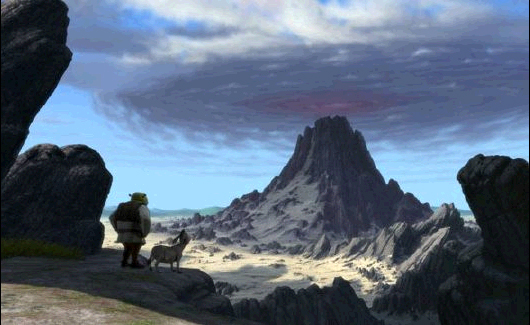 But
in early November 2000, the Imax Corp. announced it had decided not to
release DreamWorks' Shrek project in 3-D to their theaters. According
to the Hollywood Reporter, the decision was made due to increased costs
related to creative changes that had been made by D'Works. Imax big
shot Brad Wechsler revealed, "DreamWorks wanted to change some of the film.
There were new creative costs." DreamWorks spokesperson Vivian Mayer
added "Discussions with Imax have ended, and we are discussing other options."
Nevertheless, in May 2001, Jeffrey Katzenberg himself confirmed: "We are
creating a 3D digital IMAX file. When and where and how we get it out there
to the world, I'm not sure of. But I'm sure that the film will be
of great value one day."
But
in early November 2000, the Imax Corp. announced it had decided not to
release DreamWorks' Shrek project in 3-D to their theaters. According
to the Hollywood Reporter, the decision was made due to increased costs
related to creative changes that had been made by D'Works. Imax big
shot Brad Wechsler revealed, "DreamWorks wanted to change some of the film.
There were new creative costs." DreamWorks spokesperson Vivian Mayer
added "Discussions with Imax have ended, and we are discussing other options."
Nevertheless, in May 2001, Jeffrey Katzenberg himself confirmed: "We are
creating a 3D digital IMAX file. When and where and how we get it out there
to the world, I'm not sure of. But I'm sure that the film will be
of great value one day."
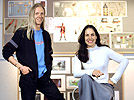 Generating
laughs was priority one for the creative team behind "Shrek," so it's no
surprise that some of today's biggest comic talents bring the characters
to life. With the stellar cast in the recording booth, laughter filled
the sessions. Co-director Victoria Jenson reveals that Myers in particular
couldn't resist an opportunity to clown. "He was just cracking us up all
the time. He's got an amazingly intelligent sense of comedy and what makes
something entertaining," she said. "When he'd explain a point, he'd go
into character as Michael Caine or Christopher Walken, imitating how they
would deliver a line. I know he was trying to make a point. But we were
just laughing so hard."
Generating
laughs was priority one for the creative team behind "Shrek," so it's no
surprise that some of today's biggest comic talents bring the characters
to life. With the stellar cast in the recording booth, laughter filled
the sessions. Co-director Victoria Jenson reveals that Myers in particular
couldn't resist an opportunity to clown. "He was just cracking us up all
the time. He's got an amazingly intelligent sense of comedy and what makes
something entertaining," she said. "When he'd explain a point, he'd go
into character as Michael Caine or Christopher Walken, imitating how they
would deliver a line. I know he was trying to make a point. But we were
just laughing so hard."
Jenson describes her partnership with Adamson as being "kind of separate and kind of side-by-side." During the early stages of story development, the duo was virtually inseparable as the action unfolded. As "Shrek" began to take shape and specific segments were agreed upon, the directors split the film in half -- each working on a specific number of scenes.
"That way we could focus our attentions on all of the tiny details of each sequence -- from story, to production design, through the editorial process where you are constantly with the animators," continued Jenson, who added that each director was also in charge of his or her particular scenes when the actors were in the recording studios.
The partnership also meant a constant dialogue between the two. Neither went very far in the process without input from the other. 'I'd work on a sequence with a story artist for a week or so then after it got to a certain stage, we'd present it to Andrew and our producer,' said Jenson. This also held true during the animation process where the directors reviewed all the dailies together. "Even though there'd be a lead director on a particular shot, we would discuss it," she continued. "We would discuss it with the other animators as well -- what was working and what we could make better."
Jenson does admit she had a particular preference to which scenes ended up in her charge. "I tended to gravitate to some of the more goofy sequences," she said. "My background is 3D. I worked with Ralph Bakshi and John Kricfalusi. So I look at comedy just by itself. If it's entertaining—let's keep it. Let's never lose a laugh."
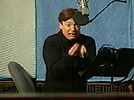 While
the directors were laughing at Myers, they also closely listened to what
he was saying. Many of Myers' offhanded comments became key to finding
Shrek's character. "They certainly helped the character evolve. Because
we were constantly working the sequences, some of his earliest ad-libs
helped us find a direction for a particular sequence," continued Jenson.
"Even after we layered some sequences, he'd say, 'You know what would be
a great line right here' and we'd go back and put it in."
While
the directors were laughing at Myers, they also closely listened to what
he was saying. Many of Myers' offhanded comments became key to finding
Shrek's character. "They certainly helped the character evolve. Because
we were constantly working the sequences, some of his earliest ad-libs
helped us find a direction for a particular sequence," continued Jenson.
"Even after we layered some sequences, he'd say, 'You know what would be
a great line right here' and we'd go back and put it in."
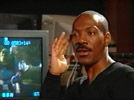 Murphy,
on the other hand, took a much more serious approach to his character.
As the sassy, self-effacing sidekick, he gets most of the film's funniest
punchlines. The comedian therefore focused the lion's share of his energy
on his performance. "He almost had blinkers on until he got behind the
microphone and then -- boom--he was the character," said Jenson. "He would
grill us on something if he didn't understand it. But once he got the concept,
he would completely own it. Sometimes he'd end up with something we didn't
expect, but it was always funnier than we'd expected."
Murphy,
on the other hand, took a much more serious approach to his character.
As the sassy, self-effacing sidekick, he gets most of the film's funniest
punchlines. The comedian therefore focused the lion's share of his energy
on his performance. "He almost had blinkers on until he got behind the
microphone and then -- boom--he was the character," said Jenson. "He would
grill us on something if he didn't understand it. But once he got the concept,
he would completely own it. Sometimes he'd end up with something we didn't
expect, but it was always funnier than we'd expected."
Jenson and Adamson's main goal was to make "Shrek" as funny as possible. But the duo, along with a team of almost 400 animators, also set a mandate to push the art of computer animation to new heights.
As amazing as such CG predecessors as "Toy Story," "Antz" and "A Bug's Life" were, they were still limited when it came to animating certain items in the computer. At a 'work-in-progress' sneak preview last March, DreamWorks' co-founder Jeffrey Katzenberg stated that there are considered to be three 'Holy Grails' of computer animation. -- hair, liquid and fire. "Shrek" brilliantly tackles each. But this is only a small part of the lavish storybook world the movie brings to life.
"This is the first time you really see humans appear in principal roles in a CG film," added Jenson. "Nobody really knows what an ogre's supposed to look like or how a donkey talks, but everybody knows how humans move and speak. These characters needed more believability. We ended up building models with anatomy and muscles that the animators pulled to make an arm move or to shape a mouth."
The animators discovered the best way to heighten the realism of the princess, Lord Farquaad, and his subjects was to concentrate on the subtleties of the human form. "We built translucent layers of skin so they wouldn't look like plastic," Jenson said. "You really see that in Fiona in her close-ups. Light could actually pass through to create a luminosity. We painted freckles or warm tones a couple of layers down and light would pass through the skin to them. It just looked a lot more believable."
"This is state-of-the-art for right now," said Andrew Adamson. "As Jeffrey
[Katzenberg] likes to put it, it's probably state-of-the-art for two and
a half minutes, until the next film comes out that's state-of-the-art."

INTERVIEW WITH JOHN LITHGOW, MIKE MYERS & CAMERON DIAZ
Question: What exactly made you want to
be involved in this movie?
John Lithgow: They asked me, it was four or five years ago, and Jeff
Katzenberg proffered the offer, and it was presented to me as the very
beginnings of the Dreamworks animation program. By that time "Antz" was
already underway and "Prince of Egypt", but it was still in the infancy
stage. They had bought this wonderful book called "Shrek" by William Steig,
whom I consider to be one of the great children’s book authors. At the
very heart of it, there was no reason to say no. They asked, and I said
yes.
Q: Were you nervous, creating a performance that would be mostly
in the hands of other people?
JL: You do the voice for one of these major animation features, and
you don’t know if it will turn into something spectacular or not. One way
or the other, it’s not a lot of work. I was just delighted to do it.
Q: Did you need to do a lot of inventing with the character, or was
it already pretty well defined?
JL: They explained what they considered to be the main visual joke
of Lord Farquaad, that he’s a little character with delusions of grandeur.
They liked the idea of a voice that did not fit his body, just as his self-image
does not fit with reality. I had no idea how well this visual joke would
work until I saw it animated. You’re sort of working in the dark when you’re
the voice of an animated character. No matter how well they describe it,
no matter how many storyboards they show you, you don’t really know what
you’re doing until you see it. And then you see it four years later, and
you’ve forgotten what you did in the first place.
Q: Was it strange to be doing voiceover work, as opposed to what
you're normally used to doing on a film?
JL: Well, like no other acting, you are nowhere near any other actors.
You’re all by yourself in the recording studio. There are two other people
with you in the studio. They provide you with a good actor to feed you
your cues, but he is not one of the people you actually play the scene
with. This all takes some getting used to. Then there’s a video camera
guy, filming you so that they have a video record of everything you did
while you were talking. They know that you don’t just speak with your mouth,
that your face does all sorts of things, that you get your entire body
into it, and they use that as a visual reference point when they’re animating.
It’s one of the first things that they do – they have the script and design
the characters, but the animation doesn’t start in earnest until they have
the voice. I compare an animated film to a big skyscraper – the voice is
the steel girders, and they build around that.
Q: You did do another animated voice recently when you played Jean-Claude
in the second "Rugrats" movie. Was there a noticeable difference between
doing that movie and "Shrek"?
JL: "Rugrats" was an extremely different experience. It’s an animation
style that goes much faster, as they crank out a "Rugrats" once a week,
it’s much simpler animation because it’s that old fashioned, rudimentary
look. They worked lightning fast. My sessions on "Rugrats" would sometimes
last no more than twenty minutes. I always thought that the director on
that movie must have been high on something, because I would go to the
studio and then be home half an hour later. "Shrek" was far more painstaking,
although I’m embarrassed to say that about any animated work [from an actor’s
point of view]. If you put together all the work I did on "Shrek", I would
say I have spent more time promoting it in the last three days than I did
actually working on it. It was probably about twelve, thirteen hours of
work spread out over four or five years. When you compare that to the amount
of work that the animators and producers put into it, I’m embarrassed to
get all the attention and praise for it.
Q: Did you ever get to meet your co-stars in the film, or was your
voice-over work done completely separately?
JL: I met Eddie Murphy for the first time yesterday, at about 3:30.
Q: So they kept you all very separate, then.
JL: Yes. You’re working with a bunch of animators, and they’re getting
exactly what they want from you, and nothing else. They’re getting that
voice. In the same way, they have several animators working exclusively
on your character, and those animators have nothing to do with Shrek or
Donkey or the Princess. It's all very specialized. Last year I took a tour
and met about two hundred people working away on this film, as they had
been working for four years. I was amazed – that was the day I realized
that I was in something very, very special. On that day I met the guy who
was in charge of dust, the guy in charge of mud, the person who does leaves
blowing in wind, the person in charge of milk being poured, the one who
oversees all other liquids, and each of these people had worked for years
on their particular skill. And I would sit in one cubicle after another
and watch them work on their video monitors. There is extraordinary craft
and expertise involved, and it’s all shot with this amazing, ridiculous
sense of humor that they all share.
Q: Did all this make it tough to create a character?
JL: I don’t create the character. They do. The animators have these
sessions with Eddie, Cameron and Mike and they have everything on tape
and then create around that.
Q: Did you at least get to see animated sequences from time to time
to get an idea of what was going on in a particular scene?
JL: Very late in the process they had little scraps of animation to
show me. They showed me a scene between Shrek and Donkey. It was such a
thrill the first time I saw Donkey.
Q: "Shrek" is a display of the state of the art of CGI (Computer
Generated) animation. What are your feelings about CGI?
JL: This animation is very new, it’s like raising the bar. Seeing movies
like this and "Toy Story" must be like seeing "Snow White" when it first
came out in the 1930’s.
Q: This movie has a lot of adult humor in it, as well as the stuff
aimed at the kids. Did any of the adult jokes seem too inappropriate to
be in the movie?
JL: No, as long as it's done correctly. One of the things I always
loved about British Theater was the Annual Christmas British pantomimes,
which are these corny old fairy tales that are put on as musicals. The
principal boy is played by a girl and the ugly sisters are played by guys
in drag. "Peter Pan" the musical was very much in that tradition. It is
a particular tradition developed over centuries, this ability to put on
a show for the entire family, where the adults and the children are laughing
at the same time, at the same jokes, for completely different reasons.
And the adults like it, particularly, because they realize that the kids
are oblivious to what’s so funny about it. It’s a huge, electric moment
when these jokes pay off, and that’s what "Shrek" is all about. It’s very
rare. In a way, that’s what we were always trying to achieve on "3rd Rock",
appealing to lots of different audience constituencies at the same moment.
Q: What would you consider to be the highlight of your career?
JL: I’ve had many highlights in many different areas. The best movie
I was ever in was probably "Terms of Endearment", although in my opinion
the best acting performance I ever gave was in "The Twilight Zone" film.
"3rd Rock" is also a highlight, and then there’s the theater as well. There’s
a curious bunch of unexpected thrills in my career as well. I’ve recently
started performing big orchestra concerts for kids, and I’ve played twice
in Carnegie Hall, once with the Chicago Symphony, and you can’t imagine
how exciting that is.
Q: You were such a great bad guy in films like "Raising Cain", "Cliffhanger"
and "Ricochet". Do you like playing the bad guy?
JL: I do. Lord Farquaad is an over-the-top comic villain. But I did
enjoy the comic spin of villains in movies like "Cliffhanger". I was very
well aware that I would get a few laughs. The villain is a fun part. You
can have too much of it, just like you can eat too much steak, but it is
a lot of fun. I provided only a half of the comedy for Lord Faarquard.
I knew, for example, when we did the dialogue of the Gingerbread Man scene,
that this was funny stuff. There was nothing I had to add to that. It was
funny on the page.
Q: How much preparation went into this role?
JL: I must confess I prepared virtually nothing for the part of Lord
Farquaad. I’d come in loose as a goose into these recording sessions and
just let ‘er rip. You don’t have to learn anything, you don’t have to perfect
an accent. I didn’t really know what they wanted until I got there, and
I think the creators themselves like to maintain a certain improvisational
atmosphere.
Q: Often times these animated movies get spun into weekly cartoons
or regular series. Would you have any interest in revisiting the midget
Lord someday?
JL: I would have to say no to a weekly "Shrek" gig. They had a weekly
"Harry & The Hendersons" show, but they never even asked me to be in
it, just moving right on to Bruce Davison.
Q: What are your favorite fairy tales?
JL: I used to love the Grimm tales. My Dad used to read to us kids
from a fabulous volume called Tellers and Tales. He also used to read to
us from "The Jungle Book". I myself discovered a wonderful Grimm story
called “The Giant With the 3 Golden Hairs”, which I used to tell to my
children and got very good at stretching it out over a long period of time
when we were waiting on line in Disney or wherever.
Q: Was it unusual to work on a film with two directors?
JL: No. I worked with lots of people, including the directors. Vicky
[Jenson] and Andrew [Adamson], the Directors, are marvelous people. Those
were the voices I would hear. You’re in the room with the mike, and everybody
else is behind the glass. You can’t hear them, and then you’ll do something
and see eight or nine people all speaking feverishly to each other. Being
an actor you get intensely paranoid, you’re afraid they’re all saying,
“Don’t you think James Woods would be better for this part?” Finally they
reach a consensus, and you see one of them lean forward and say into the
mic, “John, could you do that a little louder and faster?” The directors
were delightful, they have a wonderful, offbeat sense of humor. They knew
what they wanted, and that’s all you could ever want from a director. I’ll
give a director anything, as long as they’re clear about what they want.
Read then listen to Cameron Diaz and Mike Myers talk about Shrek!
Question: How did you become involved with
this project?
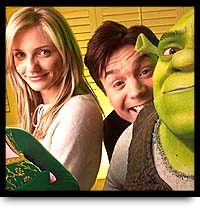 Myers:
[DreamWorks executive] Jeffrey Katzenberg asked me [if] I would like to
be in an animated fairy tale. He said that Eddie Murphy, Cameron Diaz and
John Lithgow would be in it and I said, "Yes, please." I asked him what
it was about, and he said it was about an ogre who starts out unhappy with
being an ogre and ends up accepting himself as an ogre.
Myers:
[DreamWorks executive] Jeffrey Katzenberg asked me [if] I would like to
be in an animated fairy tale. He said that Eddie Murphy, Cameron Diaz and
John Lithgow would be in it and I said, "Yes, please." I asked him what
it was about, and he said it was about an ogre who starts out unhappy with
being an ogre and ends up accepting himself as an ogre.
Q: [To Myers] So you were among the last to sign on to the project?
Diaz: Well, I was told that you were going to do it! See how
things happen? They called me up and asked if I wanted to be in an animated
fairy tale and that the story was about an ogre and a princess and how
they become accepting of themselves and one another and the beauty of that
message. I said, "That sounds great. Who is doing it?" And they said, "Mike
Myers, Eddie Murphy and John Lithgow" and I said, "Please, can I do it?"
Q: How much input did you have with the characters?
Myers: It was extremely well-written [by Ted Elliott & Terry
Rossio and Joe Stillman and Roger S. H. Schulman]. I have written everything
I've done for the most part. So, I just loved coming in and just micro-managing
one part. And I thought the story was great. I would hear what John and
Eddie and Cameron had done, and I thought they were brilliant. They really
sparked me creatively.
Q: How does the process of taping and matching your voices to the
animation work?
Diaz: There wasn't a script or anything. You come in and there
is a storyboard. I learned how the acts sort of played out the first time
I went in to work with them. Andrew [Adamson, co-director of the movie
with Vicky Jenson] would stand with his retractable pointer stick and sort
of act out each story point. I didn't even see the end of the story when
I first started working on it. They had not finished the storyboards yet.
The first time I read it, and then I just did it. After you watch it, you
say, "Now I get it." I've seen the movie, and now I get the character and
I understand what she was going through. And you kind of just say, "God,
I wish I had known that before I did this!"
Q: That seems like a difficult way to get in character or to act
if you don't know where you're going with the performance.
Diaz: Yes, it's a strange process. It happens over several years.
You do a performance, then they animated over about two years, then you
do another performance [in what amounts to looping dialogue that doesn't
quite work], and they take that.
Q: So how do you become the character?
Myers: I had done Shrek as a Canadian [affecting a Canadian
accent] like, "I'm an ogre, eh?" I'm very proud to be Canadian and everybody
was very happy with how it turned out, but I knew I could give more to
it. My mum is from Liverpool, England. She's a trained actress. When I
was a kid she used to read fairy tales to me. The bookmobile would come
by, and fairy tales would be in the back of the bookmobile. My mum would
read all the different parts. So all children's books and fairy tales have
English accents to me. Like, Curious George is from London, Babar is from
Liverpool. I realized I wasn't making that nice connection to the
process and to Shrek because it was missing that Mum connection. Once I
had made that connection--he's Scottish and had been living in Canada for
like 20 years--once I'd made that connection, it all opened up for me in
terms of my heart energy and warmth for me. There was not one molecule
of cynicism about this process. And I got inspired hearing Eddie and Cameron
and John and how committed they were. I thought, "Wow, I've got to dig
deeper." After a while I didn't feel I was doing a movie with Cameron Diaz,
I thought I was doing a movie with Princess Fiona.
Diaz: Yes, it's weird how the process is, huh? I mean I know
what Mike Myers looks like, but it's just that you are watching Shrek,
Donkey, and it's Princess Fiona who is relating to them. It becomes their
little story.
Myers: In a weird way, it locks you into the character even
more. After a stressful day, I got to spend two hours with Princess Fiona
and Donkey and Lord Farquaad. It did remind me of when the bookmobile would
come by and I would go sit on the furry cube of the children's section.
At first I was lost, but over time you know [what to do] in the movie.
Q: Do you think this movie will catch on with a diverse audience
in terms of age?
Myers: In Britain they have these things called the Pantomimes
at Christmas. They have these Christmas shows--it's kind of like a big
party. A pretty girl will play the young lead male, an older established
comedian will play the witch. There is a lot of cross-dressing and gender-bending.
There are a lot of jokes that are torn from today's headlines set against
Rumpelstiltskin or something like that. There are jokes for the parents
and jokes for the kids. The parents are laughing at the jokes that are
more topical, and the little kids are looking at the lead character and
saying [in his best English accent], "Look out behind you! Look out behind
you!" There is a lot of this in the movie. Eddie is so hilarious as the
donkey that he gives a contemporary touch to the fairy tale.
Q: It does seem like you played the part very straight--as a dramatic
role.
Myers: I did approach it as a dramatic role. The message of
the movie is so great and it's so important. I was in Toronto and a 9-year-old
kid was eating a hot dog and she said, "Oh, I have to go exercise for an
hour now to work this off." I thought we are in a time right now where
a handful of people are deciding what is normal, what is pretty and what
is an appropriate body image. . . . I just don't remember that as a kid.
I know I'm a boy and it's different for girls, but I just don't remember
girls saying, "Oh, I have to go work out" at such a young age.
Diaz: I think body image is something that has always been there
for girls. I mean, women have been corseted for half their existence. But
now it's so global and the media is at us at all ends from television to
radio, [dictating] what sort of image is OK and what perfect is and what
you should aspire to be. I mean, even myself.
Q: But you are kind of the model for these girls:
Diaz: Only because I polish up nicely. I'm not saying, "You
have to look this way." If any girl puts on makeup or puts something on
that she feels good in, then she will be as beautiful as she can be.
Myers: If I may, I think Cameron is very, very good-looking.
. . .
Q: And thin.
Myers: But that is not the issue. The issue with Cameron is
how incredibly charming in herself she is. With "Charlie's Angels," what
struck me--and I loved it, I've seen it four times--was how each of the
characters was their own person and made no apologies for who they are.
That they are all really good-looking is nice, but what I came away with
in the movie is not that you are supposed to be good-looking but that you
have to be yourself. They were this really great gal team making no apologies
or excuses for who they are.
Diaz: Exactly, it's not like I've ever said you have to look
like me, or this is the ideal woman.
Q: It's more like the media imposes it.
Myers: That's true
Diaz: Certainly. But, truth be known, I appreciate what you
said, Mike, in that beauty comes from within. I mean, someone said to me
today, "But you've got to know that being beautiful makes it so much easier
to be in the world." And I think that what makes it easier to be in this
world is being a kind, patient person, because when you are patient you
can put up with the ignorance of everyone else. Truth be known, I've
wished my entire life I could be 15 pounds heavier. Believe me, I've tried.
I eat like a cow, but I don't put the weight on. This is who I am, and
so I have to accept this is who I am and I'm OK with that. It's about accepting
who you are.
Q: And you've played roles where beauty is not an issue, like in
"Being John Malkovich."
Diaz: Yeah. To me, I look at Lotte [her character in that film]
and I really loved her. I liked her so much I wanted to be her more than
I wanted to be myself. It was a relief when I could be in her skin.
The people you work with in this business, some are really good-looking;
others are just incredibly charming. Whatever you are watching on the screen,
what you are seeing is not just the looks of people. There are a
billion people in Los Angeles who are good-looking. If all it took was
for you to be handsome or gorgeous to be on the screen and make a living
at it, then everybody would be successful. But it's what you have inside,
it's what you emote, that is what film really sees.
Director Andrew Adamson chose to replace the earlier tournament scene with the WWF spoof because to add the wrestling sequence to the already scripted competition would have made the scene too long.
"If you're doing comedy and parody, you want to stick to one idea to keep it clean," Adamson said. "We felt like that sequence worked best as mainly a WWF parody. [Before], it was basically just a whole lot of gags around traditional tournament ideas; guys coming out jousting and Shrek grabbing the jousting poll and flipping them over. He would have still done the thing where he knocked the spickett out of the ale keg and turned the whole field to mud, and we had him waterskiing, or mudskiing, behind one of the horses holding onto the horse's tail. It's an aesthetic choice you make as you're going."
The filmmakers also cut a lot of cameos from famous fairy tale characters from the early storyboard scripts. In the beginning of the movie when Shrek scares off a gang of ogre hunters, he was originally supposed to encounter Mary searching for her lost lamb. Jenson said Mary got cut to simplify the introduction of the fairy tale subplot.
"We knew we wanted to establish him as a loner and not wanting anyone on his land, but it just seemed cleaner to have humans come in trying to hunt him and the fairy tale creatures getting introduced when they're dumped onto his swamp," she said.
The scene of fairy tale characters in the swamp also included some extra gags in earlier script drafts. According to Adamson, Goldilocks had been considered, but in the final film the three bears appear without her. Another gag involving Jack and the Beanstalk had to go because it interfered with the scenery.
"Shrek at one stage had come out of the swamp and knocked over a farmer with a cow and the beans fall on the ground and the beanstalk grew throughout the sequence," Adamson explained. "Then at the end he was walking away and behind him you saw this giant fall and land on his house. Without turning around Shrek just said, 'I don't even want to know' and just carried on walking. We cut that obviously because we wanted to leave his house intact."
There were also more fairy tale encounters as Shrek and Donkey escorted Fiona back to Farquaad's castle. Jenson described a proposed encounter with the witch from the Hansel and Gretyl story.
"We had at one point Shrek, Donkey and Fiona going through an enchanted forest and ended up at a witch's gingerbread house," she said. "Her whole front lawn was completely booby trapped with lasers and sticks that come out of the ground. Shrek had to dive through all these things. Cute little bunnies would jump up and shoot blow darts at him as he tried to do a military jump and tumble to get into the house and save Fiona and Donkey. He ends up getting trapped himself and the three of them are hanging near a cauldron while this witch is mixing a brew and the three of them sort of work together to turn her spell back on her. It was fun, but I don't know if we even put it into a test screening. I think that it was kind of a long sequence and I think we pulled it before we even tried it in a test."
Adamson said he and Jenson ultimately chose the fairy tales that served the story or comedy best.
"What we would do quite often is we'd get in a brainstorming session
with the storyboard artists and say everyone has to come up with three
or four fairy tale gags," Adamson said. "Out of those we'd end up picking
the best for one reason or other, maybe they fitted the flow of the sequence
better or maybe the others were just funnier."
PDI USES 3D GRAPHICS TO CREATE FAIRY-TALE HAVOC
From the April 2001 issue of Computer Graphics
World
Article by Barbara Robertson
Once upon a time, in a land not so far away, 275 people were given a daunting task: They had to transform zeros and ones into a rich landscape filled with delightful and sometimes rude creatures who would tell a tale so fascinating and funny that millions of citizens, perhaps even teenagers, would leave their homes to go see it. The 275 people huffed and they puffed. Slowly an enchanting world began to take shape. And then, as if by magic, three years later the zeros and ones were completely transformed-into a hilarious movie called Shrek.
 Shrek,
based on the children's book by William Steig, is the second animated feature
from PDI/DreamWorks, which previously created Antz,
and the fifth feature-length film created entirely with 3D computer graphics.
Directed by Andrew Adamson and Vicky Jenson, the animated comedy adventure
stars, as voice talent, Mike Myers in the title role of Shrek, an ornery
ogre; Eddie Murphy as Donkey, Shrek's wisecracking, fast-talking, sidekick;
Cameron Diaz as Fiona, a beautiful princess with a deep, dark secret; and
John Lithgow as Lord Farquaad, an anal-retentive, power-hungry villain.
What more does a shattered fairy tale need? Well, certainly a fire-breathing
dragon, knights in shining armor, gnomes, and fairy godmothers, and this
movie has all that and more.
Shrek,
based on the children's book by William Steig, is the second animated feature
from PDI/DreamWorks, which previously created Antz,
and the fifth feature-length film created entirely with 3D computer graphics.
Directed by Andrew Adamson and Vicky Jenson, the animated comedy adventure
stars, as voice talent, Mike Myers in the title role of Shrek, an ornery
ogre; Eddie Murphy as Donkey, Shrek's wisecracking, fast-talking, sidekick;
Cameron Diaz as Fiona, a beautiful princess with a deep, dark secret; and
John Lithgow as Lord Farquaad, an anal-retentive, power-hungry villain.
What more does a shattered fairy tale need? Well, certainly a fire-breathing
dragon, knights in shining armor, gnomes, and fairy godmothers, and this
movie has all that and more.
With each new 3D animated feature, Toy Story,
Antz,
A
Bug's Life, and Toy Story 2,
the backgrounds and characters have become more varied, complex and detailed;
the make-believe worlds have, in effect, become more three-dimensional
in every way. Shrek, like all these films before it, has raised the bar
again.
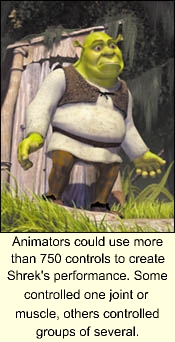
The theme of Shrek is about not taking stereotypes and fantasies for granted, and the movie cleverly uses fairy-tale conventions and characters to make the point. "Whenever possible, we try to take a fairy-tale stereotype, set it up as a fairy-tale stereotype, and twist it in a comic way," says Adamson. "I've always thought that fairy tales don't have great messages: If you don't go to bed, the ogre is going to get you. If you meet your knight in shining armor, who is always a perfect, handsome prince, everything will be all right. So it's been fun to use pretty much every fairy tale ever told as huge comic fodder."
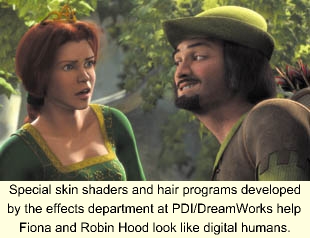
Such a character
"Oh. You were expecting Prince Charming?" says Shrek to Princess Fiona when, after rescuing her, he takes off his helmet to reveal his true identity.
For character creation and animation, PDI relies almost exclusively on its proprietary software tools, which have evolved during the 20 years the studio has been working with 3D animation. For Shrek, various teams developed new tools for that proprietary system in nearly every area-the underlying animation system, character set-up, cloth simulation, methods for creating crowds, and the rendering of skin, hair, and fur.
Modelers started building the digital characters by using data scanned from a sculpted maquette and imported into Alias| Wavefront's PowerAnimator and Maya or Avid's Softimage|3D, but this was only the beginning. Shrek's 3D model went through 50 revisions, and Fiona's face took a year of experimentation before the team got the look they wanted. Shrek's model lost weight to make him younger looking and easier to animate; Fiona's face became softer and more realistic.

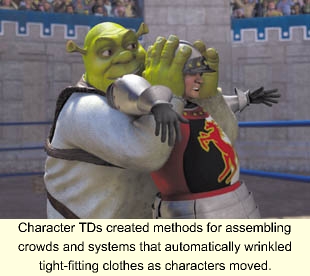
The Right Moves
Animators moved joints and muscles using animation controls; high-level controls organized by character TDs allowed them to manipulate several animation controls at once. When an animator turned Shrek's head, for example, wrinkles would automatically form on the back of his fat neck. Similarly, the animators could use high-level controls to cause characters to crack grins, make fists, or move their chests to simulate breathing. Dick Walsh, lead character TD, describes the system: "When you decide you want to smile you don't think, 'I'm going to make my cheeks puff, I'm going to expose my teeth,' you just smile and stuff happens. That's the way our system works. We define the muscles a smile will activate, and from that point on everything happens; the muscles pull the flesh around. We stabilize certain areas of the face that in a human typically don't move, though, which helps give a sense of reality."
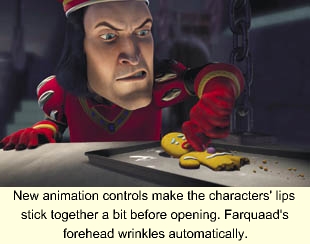
The secondary characters-the dwarfs, gnomes, fairy godmothers, guards, and so forth-were created by the character setup TDs from generic models (male, female, child) and body types (fat, skinny, slightly fatter, slightly skinnier). In addition, by tweaking the facial animation controls, they changed face shapes. With these modifications, plus changes in skin color, hairstyle, and clothing, they had enough variety even for a crowd. The variations were handed to the layout department, which organized the scenes and created the camera moves. "If layout needed a bunch of guys for a shot, they could pick head zero, body 2, tunic whatever, put those numbers on a curve, and if they didn't like the result, they could just change it," Modesto explains. Because the characters had identical setups, typical animations, such as clapping, could be copied from one generic character to another.

Although the setups for the primary characters were similar, there were necessary differences between the human types of characters and the animals. Moreover, the styles of animation varied from the energetic, cartoony Donkey to the more realistic Fiona. The tricky part for animators working with Lord Farquaad, a caricature whose style fit between that of Donkey and Fiona, was in making actor John Lithgow's big voice sound plausible in the short character. They solved the problem by exaggerating the character's chest movement each time they heard breathing in the voice track.
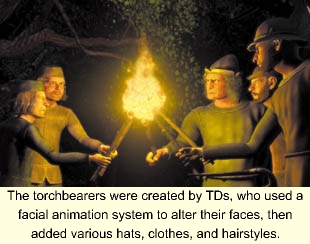
Breathing was all hand animated using high-level controls; however,
a few character motions were automated. For example, "We don't have to
animate Donkey's ears unless he's using them to show expression," Hui says.
And, when Shrek twists his body, his shirt wrinkles appropriately, thanks
to systems set up by the TDs that automatically moved relatively tight-fitting
clothing based on the motion of the character wearing them.
Wardrobe
Simulations for clothes that drape, such as Fiona's long skirt and Farquaad's cape, were created by the effects department, a catchall group that stepped in to develop special rendering shaders, global procedural systems, and techniques for animating non-character elements that needed to deform.
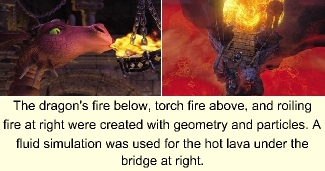
With more than 700 shots requiring dynamic clothing, many with 20 or
30 characters, the team needed to devise an efficient process for simulating
the movement of clothing on the animated characters. Rather than develop
a proprietary cloth simulation system, the effects team developed a method
in which models were generated for each frame of a shot during a batch
rendering, stored on a model server, and then fed into Maya for cloth simulation.
"Once we have clothing flowing nicely around the character's legs, we export
the geometry to our model server, and at that point, the PDI proprietary
software takes over again," says An drew Harris, cloth effects artist.
To help speed the simulations, the team looked for ways to simplify the
geometry. They discovered, for example, that skirt geometry and a balloon
shape representing upper legs was sufficient for characters wearing dresses.
"We looked for the general case, for what all the characters shared," says
Bill Seneshen, effects lead.
In addition: "On this movie, we generated models only when motion would
change, and we'd store those models on a server. This saved a lot of computing
time," explains Ken Bielenberg, visual effects supervisor.
Makeup and Hair
The effects team also created skin shaders and the hair and fur systems. "The skin was tough," says Jonathan Gibbs, effects lead. "I did a lot of research and found very little in computer graphics, so I ended up across the street at Stanford reading dermatology papers." The surface shader he created simulates light bouncing inside several layers of skin.

For hair, the effects team designed a system that gave animators control yet was largely automatic. With this system, large clumps of hair created by the modeling department were put onto a character's head for the animators to pose. Inside the clumps, a hair shader could grow thousands of individual hairs, which followed the deformation of the clump. Lighting controls determined translucency and specularity.
For fur, the team used a geometry shader. In PDI's system, shaders, which are units of code, can bring up or deform geometry during rendering in the same way that surface shaders might create materials and bump maps. The fur shader, Bielenberg explains, uses triangular polygons with normals tweaked so they appear to be round. "For each piece of fur, you can control how many polygons to generate and the curvature," he says. "The curvature and the direction the hair is grown can be animated so we can get blowing fur."
This shader was used for Donkey, for stubble on Shrek and Lord Farquaad's face, for eyebrows and eyelashes, and to grow grass. "Grass is just long, green hair," Bielenberg says.
To create a scene with grass, the layout department would give ground geometry to the surfacing department, where maps would be painted to define the grassy areas. Grass softened hard edges between objects on the ground, served as groundcover in large vistas, and helped give the Shrek landscapes an organic look.
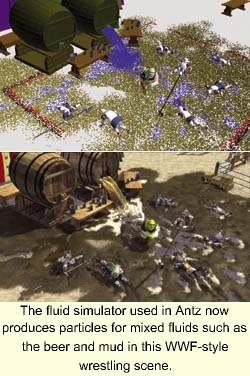
"The first CG movies were in contained worlds but because Shrek is
a quest and a journey, we wanted to create the sense of a whole world,"
says Adamson. Shrek and Donkey start in the swamp, go through rural areas
to Duloc-which Adamson describes as a kind of fascist theme park city-travel
through fields and forests to the dragon's fiery keep, and then return
the way they came.
For these environments, the modeling department created some 1500 models
and props, which the layout department organized into scenes. The effects
department provided the complexity, creating fire, fluids, and foliage.
Earth, Wind, and Fire
Fire was particularly important. "Since this film takes place in medieval times, fire is the light source, cooking source, and heating source, so we have every type of fire you can imagine," says Mark Edwards of the effects department. "We have torches, candles, fireplace fires, campfires, things catching on fire, and the dragon's fire."
Even so, the team used CG rather than live action elements to simulate the various fires. "Traditionally with effects, even in 2D animation, fire is a live action element that's composited into a scene," says Bielenberg. "We chose to use CG to have more control in motion and style. Often, though, CG fire looks too soft. We gave it a more hard-edged look that I think is extremely successful."
To do this, they used geometry at the base of many fires, particularly those in torches. This geometry is a cylinder that could be translated and deformed to match the motion of a torch being carried. Special animated shaders created a fiery turbulence inside the geometry, and particles sent the flames into the air.
In one dramatic scene, when Shrek tries to rescue Princess Fiona from the dragon, the dragon sends roiling, billowing balls of fire after them as they run across a wooden bridge. For this fire, the team used hand-animated, simulated spheres with volumetric noise shaders inside and with particle simulation helping create the final effect.
For the hot, oozing lava beneath the bridge, however, the team used PDI's award-winning fluid simulation program, FLU, created by Nick Foster, animation software developer. FLU was also put to work on the antithesis of fire-mud, an important element in a film with a swamp.
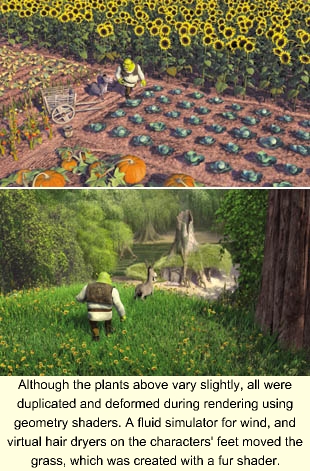
One of the difficulties in working with a fluid simulator is that it produces particles, not surfaces, and most rendering techniques rely on surfaces. Rather than generating implicit surfaces, or so-called blobbies, as is often done in these situations, the effects team used a technique called scattered data interpolation to direct and tessellate the particle information. "I think you lose too much detail with implicit surfaces," explains Bielenberg.
Adding detail to the landscapes also became a challenge for the effects team. "This is a traveling road movie that predominately takes place out of doors, so we had to create trees and leaves and grass and dirt and dust and all of the great outdoors detail," says Bielenberg.
Effects lead Scott B. Peterson and a "digital greenhouse" team, with help from Gibbs, created a system that used geometry shaders to procedurally add detail during the rendering. In this system, geometry was duplicated in the renderer, and the renderer also deformed that geometry along an X or Y axis. Thus, without storing models on disk or using a lot of RAM, the team gave each flower in a field a different pose.
Similarly, trees were stored as a series of curves that were tessellated by the renderer, and procedural techniques grew tree leaves during rendering using a series of numbers that de scribed the distribution. "It's like the ultimate form of data compression," says Gibbs.
"We wanted to create a magical storybook world, so a large part of that is the grass and trees," says Adamson. "But if there isn't a little wind blowing in the grass and the trees aren't waving gently in the breeze in the distance, the scene doesn't look three-dimensional."
After experimenting with procedural noise and even with putting springs in the trees, the effects team realized they could use FLU to create eddies of swirling motion that simulated wind. By adding oscillation to the vectors produced by the simulation, they kept the grass and leaves from looking like they were moving under water.
"I think one of our achievements was to create a full world that is as rich an environment as if we'd gone out with a camera and shot in many locations across Europe," says Adamson.
So, having created that rich world filled with delightful characters
out of simple zeros and ones, what reward was granted to those 275 people?
They get the opportunity to do it all over again for a different story
with a different look. In fact, PDI/ DreamWorks has already begun working
on its third all-CG feature film, Tusker.
Stay tuned.
|
||||||||||||